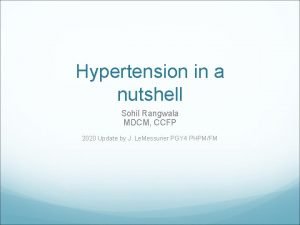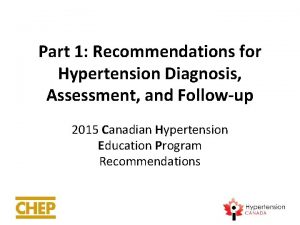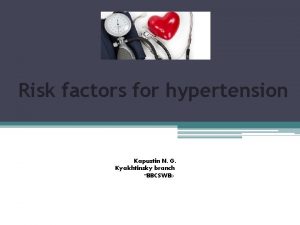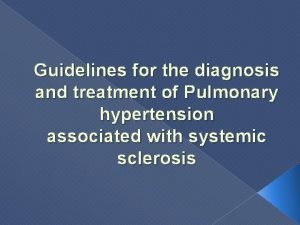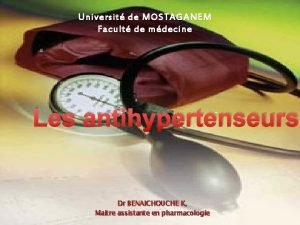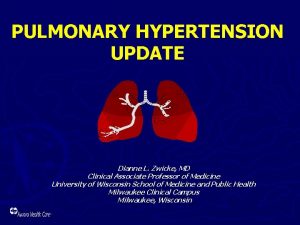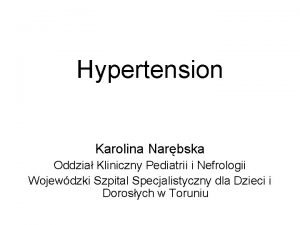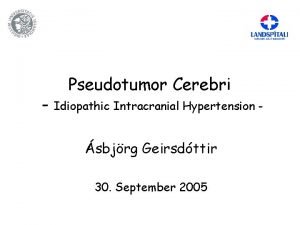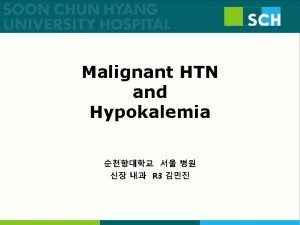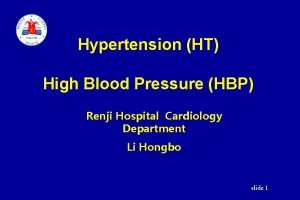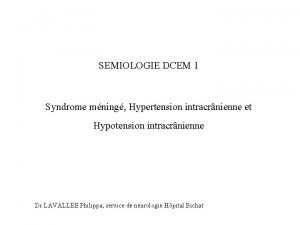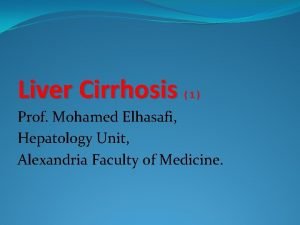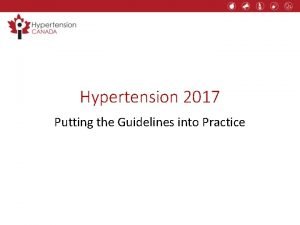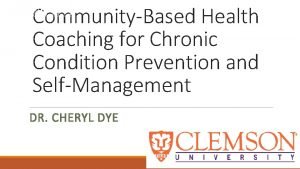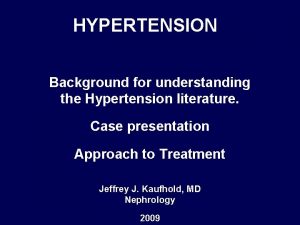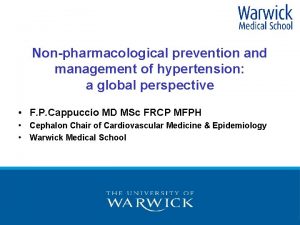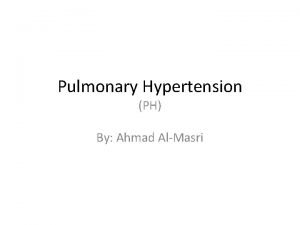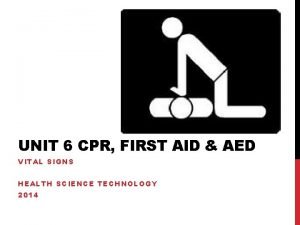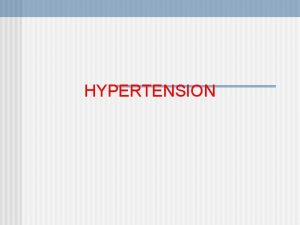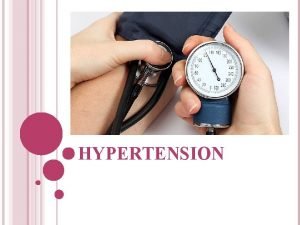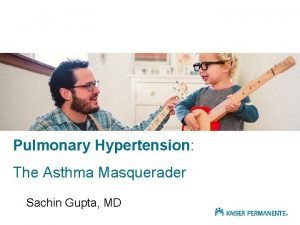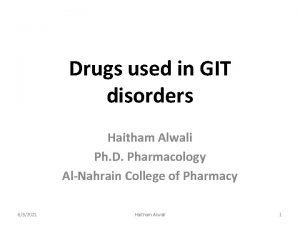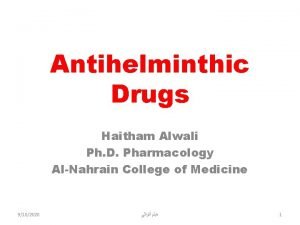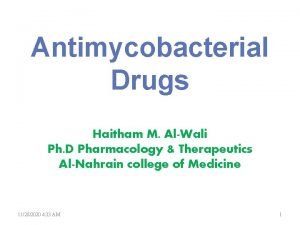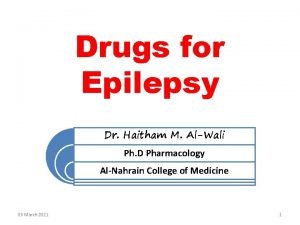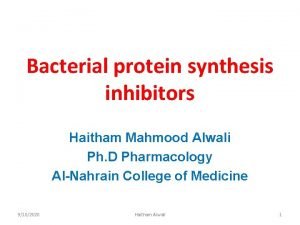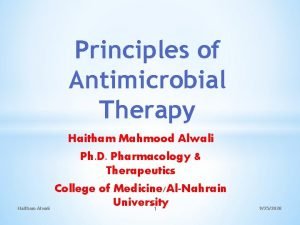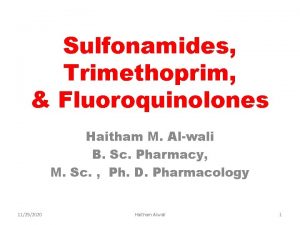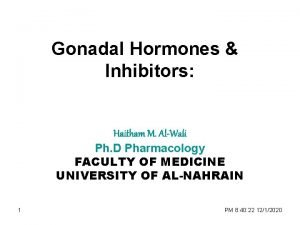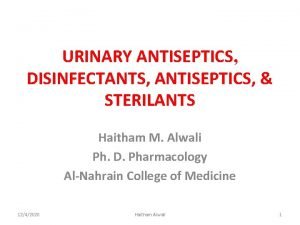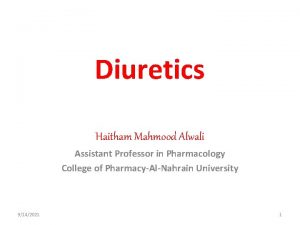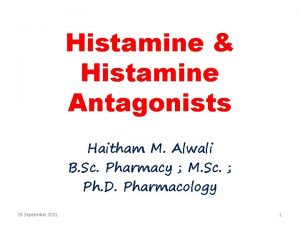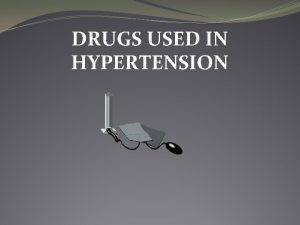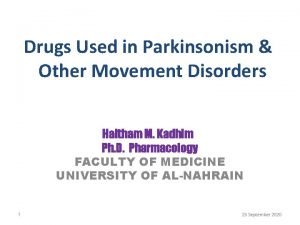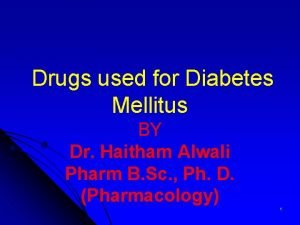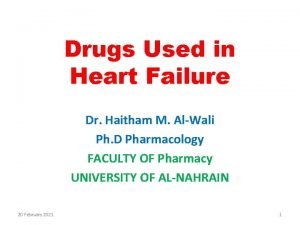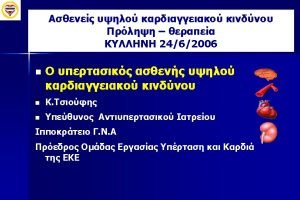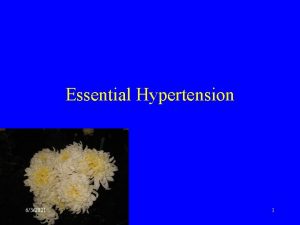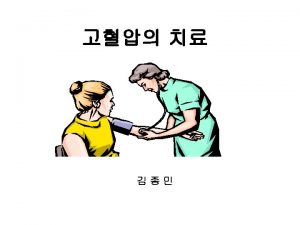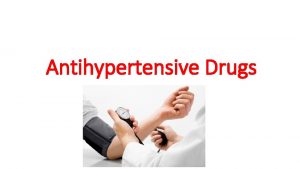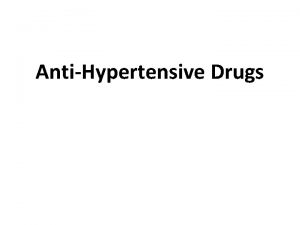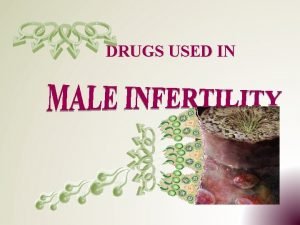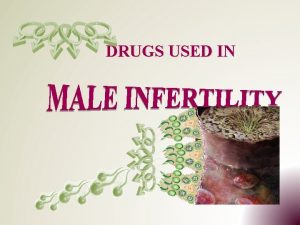Drugs Used in Hypertension Haitham M AlWali Ph

































- Slides: 33

Drugs Used in Hypertension Haitham M. Al-Wali Ph. D Pharmacology & Therapeutics Al-Nahrain college of Pharmacy 1 17 September 2020

*Hypertension is defined as: either a sustained systolic blood pressure >140 mm Hg or a sustained diastolic blood pressure >90 mm Hg *Hypertension results from: ↑↑ peripheral vascular arteriolar smooth muscle tone → ↑↑arteriolar resistance and ↓↓ capacitance of the venous system. *Hypertension affecting 15 % of the population of the United States (74 million people). *Chronic hypertension can lead to cerebrovascular accidents (strokes), congestive heart failure, myocardial infarction, and renal damage 2 17 September 2020

* 3 17 September 2020

4 17 September 2020

*ETIOLOGY OF HYPERTENSION *>90 % of patients have idiopathic, also called “primary” or “essential” hypertension *˂10% of cases of hypertension are due to (“secondary”to) factors that can be clearly defined and corrected. This type of hypertension is associated with pheochromocytoma, coarctation of the aorta, renal vascular disease, adrenal cortical tumors 5 17 September 2020

*ETIOLOGY OF HYPERTENSION *A family history of hypertension *Race: The incidence of is four-fold more frequent among blacks than among whites. *Sex: It occurs more among middle-aged males than middle-aged females * It’s prevalence increases with age and obesity. *Environmental factors, such as a stressful lifestyle, high dietary intake of sodium, and smoking 6 17 September 2020

*The strategies for treating idiopathic hypertension include: 1 - ↓ of blood volume. 2 - ↓sympathetic effects 3 - ↓vascular smooth muscle tension. 4 - ↓angiotensin effects. Unfortunately, the baroreceptor reflex and the renin response in primary hypertension are reset to maintain the higher blood pressure. As a result, they respond to a therapeutically lowered blood pressure with compensatory homeostatic responses. 7 17 September 2020

8 17 September 2020

9 17 September 2020

*TREATMENT STRATEGIES The goal of antihypertensive therapy is to reduce cardiovascular and renal morbidity and mortality 1. Current recommendations are to initiate therapy with a thiazide diuretic. 2. If blood pressure is inadequately controlled, A β-blocker may be added 3. A vasodilator can be added as a third drug for those patients who still fail to achieve goal blood pressure. ØWhen angiotensin II–converting enzyme inhibitors or angiotensin II–AT 1 receptor blockers are used to initiate therapy, a diuretic is the most common second drug added. 10 17 September 2020

q. Individualized care *Black patients respond well to diuretics and calcium -channel blockers, but monotherapy with β-blockers or ACE inhibitors is often less effective. *Similarly, β-blockers and diuretics are favored for treatment of hypertension in elderly patients(ACEs are less effective). q. Patient compliance in antihypertensive therapy β-blockers can decrease libido and induce erectile dysfunction in males, may prompt the patient to discontinue therapy. Combining two or three drug classes in a single pill. 11 17 September 2020

*DIURETICS Diuretics can be used as first-line drug therapy for hypertension safe, inexpensive, and effective in preventing stroke, MI, and congestive HF. lower blood pressure by reduction of blood volume and probably also by a direct vascular effect? Thiazide diuretics (eg, chlorthalidone, hydrochlorothiazide) and the loop diuretics (eg, furosemide). Thiazides may be adequate in mild and moderate hypertension, but the loop agents are used in severe hypertension and in hypertensive emergencies. 12 17 September 2020

*SYMPATHOPLEGICS drugs interfere with sympathetic (SANS) control of cardiovascular function. The result is a reduction of one or more of the following: venous tone, heart rate, contractile force of the heart, cardiac output, and total peripheral resistance 13 17 September 2020

*Sympathoplegics That Act in the CNS Alpha 2 -selective agonists (eg, clonidine, methyldopa) cause a decrease in sympathetic outflow by activation of α 2 receptors in the CNS. These drugs enter the CNS when given orally. ØMethyldopa is a prodrug; it is transported into the brain and then converted to methylnorepinephrine. ØClonidine and methyldopa reduce blood pressure by reducing cardiac output, vascular resistance, or both. The major compensatory response is salt retention. 14 17 September 2020

*Sudden discontinuation of clonidine causes rebound hypertension, which may be severe. This rebound increase in blood pressure can be controlled by reinstitution of clonidine therapy or administration of α blockers such as phentolamine. *Methyldopa occasionally causes hematologic immunotoxicity, and in some patients progressing to hemolytic anemia. *Both drugs may cause sedation—methyldopa more so at therapeutic dosage. *Early studies suggested that methyldopa protected kidney function and was safe in pregnancy. 15 17 September 2020

*Ganglion-Blocking Drugs Nicotinic blockers that act in the ganglia are very efficacious, but because their adverse effects are severe, they are now considered obsolete. Eg. Hexamethonium and trimethaphan 16 17 September 2020

*Postganglionic Sympathetic Nerve Terminal Blockers *Reserpine depletes the adrenergic nerve terminal of its norepinephrine stores. *Guanethidine deplete and block release of the stores of norepinephrine. produce severe adverse effects and are now considered obsolete for hypertension. 17 17 September 2020

*Adrenoceptor Blockers ØAlpha 1 -selective agents (eg, prazosin, doxazosin, terazosin) ØAlpha blockers reduce vascular resistance and venous return. ØThe nonselective α blockers (phentolamine, phenoxybenzamine) are of no value in chronic hypertension because of excessive tachycardia. ØAlpha 1 - selective adrenoceptor blockers relax smooth muscle in the prostate, which is useful in benign prostatic hyperplasia. 18 17 September 2020

*Beta blockers * are used very heavily in the treatment of hypertension. *Propranolol is the prototype, and atenolol, metoprolol, and carvedilol are among the most popular. *They initially reduce cardiac output, but in chronic use may include a decrease in vascular resistance. The latter effect may result from reduced angiotensin levels (β blockers reduce renin release from the kidney). 19 17 September 2020

*Nebivolol is a newer β blocker with some direct vasodilator action caused by nitric oxide release. β 1 -selective blockers with fewer CNS effects may have some advantages over the nonselective and more lipid-soluble agents. q. The β-blockers are useful in treating conditions that may coexist with hypertension such as supraventricular tachyarrhythmia, previous myocardial infarction, angina pectoris, and chronic heart failure. β-Blockers are also used to prevent migraine 20 17 September 2020

21 17 September 2020

*VASODILATORS Drugs that dilate blood vessels by acting directly on smooth muscle cells through non autonomic mechanisms Vasodilators act by four major mechanisms: 22 17 September 2020

*A. Calcium Channel-Blocking Agents (eg, nifedipine, verapamil, diltiazem) *Because they are moderately efficacious and orally active, these drugs are suitable for chronic use in hypertension of any severity. *Verapamil and diltiazem also reduce cardiac output in most patients. *Nifedipine is the prototype dihydropyridine, and many other dihydropyridines are available (amlodipine, felodipine, isradipine, etc). 23 17 September 2020

*B. Hydralazine and Minoxidil *have more effect on arterioles than on veins. They are orally active and suitable for chronic therapy. *Hydralazine apparently acts through the release of nitric oxide from endothelial cells. *must be combined with other drugs, usually diuretics and β blockers. However, it is rarely used at high dosage because of its toxicity. *Hydralazine induced lupus erythematosus is reversible upon stopping the drug. 24 17 September 2020

*Minoxidil is a prodrug; its metabolite, minoxidil sulfate, is a potassium channel opener that hyperpolarizes and relaxes vascular smooth muscle. *Because it can cause hirsutism, minoxidil is also available as a topical agent for the treatment of baldness. 25 17 September 2020

*C. Nitroprusside, Diazoxide, and Fenoldopam *These parenteral vasodilators are used in hypertensive emergencies. *Nitroprusside is short-acting agent (duration of action is a few minutes) that must be infused continuously. *The release of nitric oxide (from the drug molecule itself) stimulates guanylyl cyclase and increases cyclic guanine monophosphate (c. GMP) concentration and relaxation in vascular smooth muscle. 26 17 September 2020

*Diazoxide is a thiazide derivative but lacks diuretic properties. *It is given as intravenous boluses or as an infusion and has several hours’ duration of action. * Diazoxide opens potassium channels, thus hyperpolarizing and relaxing smooth muscle cells. *also reduces insulin release and can be used to treat hypoglycemia caused by insulin-producing tumors. *Dopamine D 1 receptor activation by fenoldopam causes marked arteriolar vasodilation. *This drug is given by intravenous infusion. It has a short duration of action (10 min) and, like nitroprusside and diazoxide, is used for hypertensive emergencies. 27 17 September 2020

*ANGIOTENSIN ANTAGONISTS *The two primary groups are: 1. The angiotensin-converting enzyme (ACE) inhibitors and 2. the angiotensin II receptor blockers (ARBs). ACE inhibitors (eg, captopril), which inhibit the enzyme variously known as angiotensinconverting enzyme, kininase II, and peptidyl dipeptidase, *cause a reduction in blood levels of angiotensin II and aldosterone and an increase in endogenous vasodilators of the kinin 28 17 September 2020

29 17 September 2020

*The ACE inhibitors are useful in heart failure and diabetes as well as in hypertension. *The toxicities of ACE inhibitors include: cough (up to 30% of patients), hyperkalemia, angioedema and renal damage in occasional patients with preexisting renal vascular disease (although they protect the diabetic kidney). *They cause major renal damage in the fetus and are absolutely contraindicated in pregnancy. 30 17 September 2020

*The angiotensin receptor blockers (ARBs), is represented by the orally active agents losartan , telmisartan, valsartan, irbesartan , candesartan, and other ARBs, which competitively inhibit angiotensin II at its AT 1 receptor site. *ARBs appear to be as effective in lowering blood pressure as the ACE inhibitors and have the advantage of a lower incidence of cough, although they do cause hyperkalemia. *Like the ACE inhibitors, they cause fetal renal toxicity and are thus contraindicated in pregnancy. 31 17 September 2020

*Aliskiren is a newer drug in the antihypertensive group inhibits renin’s action on its substrate, angiotensinogen *thus reduces the formation of angiotensin I and, in consequence, angiotensin II. * Toxicities include headache and diarrhea. It does not appear to cause cough , contraindicated in pregnancy q. Angiotensin antagonists and renin inhibitors reduce aldosterone levels (angiotensin II is a major stimulant of aldosterone release) and cause potassium retention. 32 17 September 2020

*Hypertensive emergency (formerly called malignant hypertension) *is an accelerated form of severe hypertension associated with rising blood pressure and rapidly progressing damage to vessels and end organs. *Management carried out on an urgent basis in the hospital. *Powerful vasodilators (nitroprusside, fenoldopam, or diazoxide) are combined with diuretics (furosemide) and β blockers *to lower blood pressure to the 140– 160/90– 110 mm Hg range promptly (within a few hours). Further reduction is then followed more slowly. 33 17 September 2020
 Haitham hassanieh
Haitham hassanieh Antihypertensive drugs
Antihypertensive drugs 7 trays in labour room
7 trays in labour room Drugs used in pregnancy
Drugs used in pregnancy Sohil rangwala
Sohil rangwala Diagnosis hypertension
Diagnosis hypertension Conclusion of hypertension
Conclusion of hypertension Pulmonary hypertension
Pulmonary hypertension Diueritique
Diueritique Hypertension
Hypertension Cld vs dcld
Cld vs dcld Dianne zwicke
Dianne zwicke Non pharmacological management of hypertension
Non pharmacological management of hypertension Intracranial hypertension
Intracranial hypertension Medical nutrition therapy for hypertension
Medical nutrition therapy for hypertension Hypokalemia
Hypokalemia Antihypertensive drugs classification
Antihypertensive drugs classification Missed some points on the visual field test for dvla
Missed some points on the visual field test for dvla Signe de kernig
Signe de kernig Definition of hypertension
Definition of hypertension Presinusoidal portal hypertension
Presinusoidal portal hypertension Masked hypertension
Masked hypertension Isolated systolic hypertension
Isolated systolic hypertension Health coaches for hypertension control
Health coaches for hypertension control Hypertensive crisis
Hypertensive crisis Non pharmacological management of hypertension
Non pharmacological management of hypertension Pulmonary hypertension definition
Pulmonary hypertension definition Thyrombocytopenia
Thyrombocytopenia Hypertension vs hypotension
Hypertension vs hypotension 6 vital signs first aid
6 vital signs first aid Hematocrit
Hematocrit Rules of halves in hypertension
Rules of halves in hypertension Sachin gupta md
Sachin gupta md Nursing management of portal hypertension
Nursing management of portal hypertension




